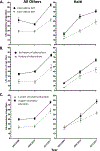Estimated life expectancy gains with antiretroviral therapy among adults with HIV in Latin America and the Caribbean: a multisite retrospective cohort study
- PMID: 33891877
- PMCID: PMC8171816
- DOI: 10.1016/S2352-3018(20)30358-1
Estimated life expectancy gains with antiretroviral therapy among adults with HIV in Latin America and the Caribbean: a multisite retrospective cohort study
Abstract
Background: There are few data on life expectancy gains among people living with HIV in low-income and middle-income settings where antiretroviral therapy (ART) is increasingly available. We aimed to analyse life expectancy trends from 2003 to 2017 among people with HIV beginning treatment with ART within the Caribbean, central America, and South America.
Methods: We did a multisite retrospective cohort study and included people with HIV who had started treatment with ART and were aged 16 years or older between Jan 1, 2003, and Dec 31, 2017, from Caribbean, Central and South America network for HIV epidemiology (CCASAnet) sites in Argentina, Brazil, Chile, Haiti, Honduras, Mexico, and Peru, who contributed person-time data from the age of 20 years until date of death, last contact, database closure, or Dec 31, 2017. We used the Chiang method of abridged life tables to estimate life expectancy at age 20 years for three eras (2003-08, 2009-12, and 2013-17) overall and by demographic and clinical characteristics at ART initiation. We used Poisson regression models to weight mortality rates to account for informative censoring.
Findings: 30 688 people with HIV were included in the study; 17 491 (57·0%) were from the Haiti site and 13 197 (43·0%) were from all other sites. There were 2637 deaths during the study period: 1470 in Haiti and 1167 in other sites. Crude and weighted mortality rates decreased among all age groups over calendar eras. From 2003-08 to 2013-17, overall life expectancy for people with HIV at age 20 years increased from 13·9 years (95% CI 12·5-15·2) to 61·2 years (59·0-63·4) in Haiti and from 31·0 years (29·3-32·8) to 69·5 years (67·2-71·8) in other sites. Life expectancies at the end of the study period were within 10 years of those of the general population (69·9 years in Haiti and 78·0 years in all other sites in 2018). Disparities in life expectancy among people with HIV by sex or HIV transmission risk factor, CD4 cell count, level of education, and history of tuberculosis at or before ART initiation persisted across calendar eras.
Interpretation: Life expectancy among people with HIV receiving ART has significantly improved in Latin America and the Caribbean. Persistent disparities in life expectancy among people with HIV by demographic and clinical factors at ART initiation highlight vulnerable populations in the region.
Funding: National Institutes of Health.
Translation: For the Spanish translation of the abstract see Supplementary Materials section.
Copyright © 2021 Elsevier Ltd. All rights reserved.
Conflict of interest statement
Declaration of interests We declare no competing interests.
Figures




Comment in
-
Life-expectancy with HIV in Latin America and the Caribbean.Lancet HIV. 2021 May;8(5):e247-e248. doi: 10.1016/S2352-3018(21)00050-3. Epub 2021 Apr 20. Lancet HIV. 2021. PMID: 33891878 No abstract available.
References
Publication types
MeSH terms
Substances
Grants and funding
LinkOut - more resources
Full Text Sources
Other Literature Sources
Medical
Research Materials

